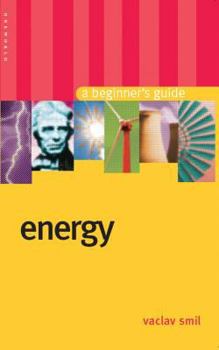Energy: A Beginner's Guide (Beginner's Guides)
(Part of the Oneworld Beginners' Guides Series, Oneworld Beginner's Guide Series, and Beginner's Guide (Oneworld Publications) Series)
Select Format
Select Condition 
Book Overview
As Einstein pointed out in his famous equation, E=MC2, all matter can be described as energy. It is everywhere; it is everything. In this engaging book, prolific author and academic Vaclav Smil... This description may be from another edition of this product.
Format:Paperback
Language:English
ISBN:1851684522
ISBN13:9781851684526
Release Date:May 2006
Publisher:Oneworld Publications
Length:181 Pages
Weight:0.64 lbs.
Dimensions:0.7" x 5.1" x 7.8"
Age Range:18 years and up
Grade Range:Postsecondary and higher
Customer Reviews
2 ratings
Delightful for nonbeginners
Published by Thriftbooks.com User , 16 years ago
This is not truly a Beginner's Guide. The book is more like an Executive Summary of the many writings by the prolific author, up to 2005. No references are given. There is no appendix with useful tables of values. However, there are many useful tables, lists and values dispersed throughout the book. The book has a few flubs: confusing ultra-violet radiation with infrared, missing a "per year" in a sentence, and draft animals pulling with kg of force. Some more serious problems occur on page 152, where the parenthetical definition of "net energy ratio" is actually the the definition of EROI, energy return on investment (of energy). The numbers discussed in the remainder of the paragraph are actually values of 1- 1/EROI . A true beginner would be flummoxed. Another grievance is that the difference between installed capacity of wind power and the actual production of electrical power is not emphasized forcefully enough. A wind production number is given on page 169 (as a percent of world electrical power), but you are on your own to figure out the important capacity factor, and then to put wind power in a fair comparison with nuclear power and coal power. The summary of wind energy is otherwise excellent, as is the summary of photosynthesis and biofuels. All ethanol fans should read it. The focus of the book in not renewable energy policy. The scope is much more grand, all done wonderfully in consistent S.I. Units, with respect for the intelligence of the reader. The author gets to the point. Energetics is the most concise way to organize knowledge of your universe. The brilliant author summarizes nearly all of it in 176 pages: your cells, your home economics, your technology, your planet. For larger scale solar and galactic - you may need to shop elsewhere. Presentation of energetics leads to implications in the sociology of jet travel, urban planning, and history of science and technology. For example, on page 93 we learn how the celebrated inventor James Watt delayed progressive development of the steam engine. The book would be a great investment of time and money if a better book was not available: "Energy in Nature and Society", published by Smil in 2008. That book has more figures, of better quality, appendices and approximately 3 times the amount of text. The overlap in not complete, though. You won't find that tidbit about Watt in the 2008 work, or the fact that swarms of insects soiling the leading edge of wind turbine blades can cause a nearly instant drop in power production by up to 20%.
Not necessarily a beginner's guide.
Published by Thriftbooks.com User , 18 years ago
This is an easy to follow guide for the beginner. You don't have to know calculus to follow the math. I daresay it could be a useful review for the more sophisticated reader.






